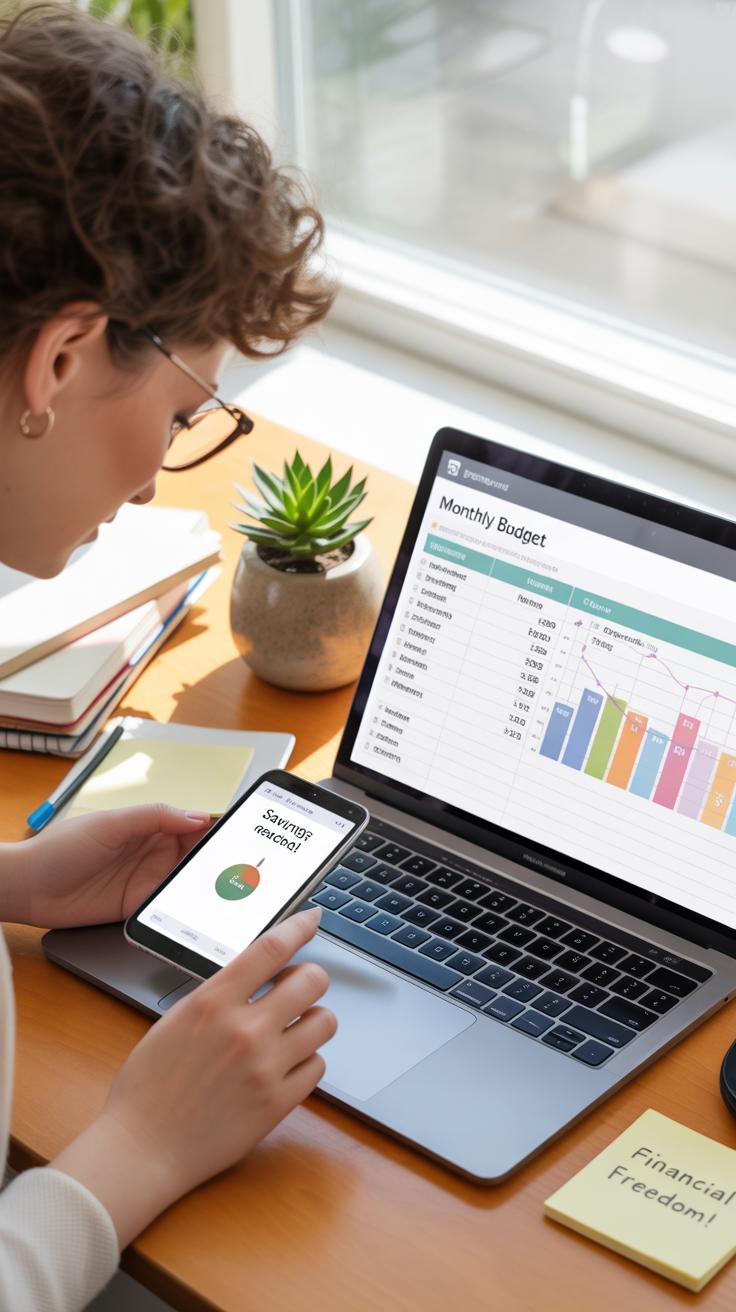Introduction
Setting financial goals with a smart financial budget plan is a key step toward managing your money well. It means deciding what you want to achieve with your money and making a clear plan on how to use your income to reach these goals. Your financial goals might include saving for a big purchase, paying off debt, or building an emergency fund.
This article shows you how to make a budget that matches your goals. You’ll learn how to list your income and expenses, choose which goals are important, and keep track of your money. By following these simple steps, you can make your financial goals real and handle your money without stress.
Know your financial goals
Financial goals are basically the targets you set for your money—what you want to save for, spend on, or invest in. They help you figure out where your money should go instead of just floating through your bank account without much direction. These goals usually fall into three groups:
- Short-term goals: things you want to achieve within a year, like saving for a holiday or paying off a small debt.
- Medium-term goals: plans set for one to five years, such as buying a used car or funding a certification course.
- Long-term goals: things that take longer than five years, like saving for retirement or a home down payment.
Knowing exactly what you want helps you avoid wasting money or feeling lost in your finances. It gives you a reason to stick to a budget, which otherwise might feel like just a bunch of numbers on paper.
Define short-term versus long-term goals
Short-term goals usually involve quick wins. You might save $500 to fix your laptop or put away cash for holiday gifts. These are more immediate and often more flexible. Long-term goals, on the other hand, involve a bigger picture. Think about saving for a down payment on a house or building an emergency fund. These require steady commitment and patience.
Sometimes people lump all goals together, but recognizing the difference changes how you approach your savings. For example, it might make sense to splurge a bit on short-term goals without derailing your bigger plans. Or conversely, focusing too much on the short term might slow long-term progress.
Why goals guide your budget
Without clear goals, a budget can feel like a restrictive list rather than a helpful guide. When you know what you’re working toward, a budget becomes a tool that aligns with your priorities. It’s easier to decide what expenses are necessary and which can wait.
For instance, if your goal is to save for a car in two years, you’ll know to set aside a certain amount monthly and avoid unnecessary expenses. Goals give your budget a purpose; they keep you motivated and on track. Sometimes plans change, sure, but having these targets gives you a clearer path, even when decisions get tricky.
List your income and expenses
Start by making a straightforward list of everything coming in and going out each month. This might seem obvious, but many people either overlook small income streams or forget recurring expenses. Writing it down gives you a clear picture of your money flow—where it starts and where it ends up.
Track where your money comes from
Identify every source of income, no matter how small. This could be your salary, freelance gigs, rental income, or even occasional bonuses. Write down each source and note how regular it is. For example, is your freelance work steady, or does it fluctuate month to month? Being clear about this helps you plan around income that isn’t guaranteed.
Count all monthly expenses
Look beyond just the obvious bills. Fixed expenses like rent and utilities are easy to list. Variable costs, such as groceries, dining out, or entertainment, can be trickier. Tracking these over a few months might reveal how “fun money” quietly adds up without you noticing. Keep an eye on irregular expenses too—subscriptions or yearly memberships that sneak into your budget unexpectedly. The goal? To grasp the full scope of your spending, not just the part you remember.
Create a workable budget plan
Start by listing your total monthly income—this includes salary, freelance work, or any side earnings. Knowing exactly how much money is coming in sets a clear starting point. Next, write down every fixed expense: rent, utilities, loan payments. These are non-negotiable and take priority.
Once fixed costs are clear, jot down variable expenses like groceries, entertainment, and transportation. These can fluctuate, so tracking them over a month or two will help you estimate better. Now, think about your financial goals. How much do you want to put aside monthly to reach them? That figure needs to be part of your budget, even if it’s small at first.
Subtract the sum of all expenses and savings from your income. If you’re overspending, consider which variable costs can be trimmed. If there’s leftover money, decide if it goes toward savings or perhaps a little flexibility fund. This process isn’t perfect from the start; you might need to adjust after a few months.
Try to keep the plan simple enough so you stick to it. Detailed spreadsheets may seem useful but can become overwhelming. A basic layout showing income, expenses, and savings breaks down everything clearly, making it easier to follow daily.
Set spending limits for each category
After calculating your budget, assign spending limits to each variable category. For instance, if you allot $300 for groceries, resist the urge to overspend just because you skip lunch out one day. Treat your budget limits as flexible yet firm guidelines.
Knowing exactly what you can spend prevents surprises at the end of the month. Try using cash envelopes or mobile apps dedicated to category limits. These tools help you stay accountable without constant mental math.
Don’t forget to reserve some room for occasional or unexpected expenses. A small “miscellaneous” fund protects you from blowing the budget altogether. The trick is not to ignore this — forgetting about it often leads to sneaky overspending.
Plan savings towards financial goals
Savings should never feel like an afterthought. Prioritize it as a regular expense, like rent or utilities. Set up an automatic transfer the day you get paid so you’re not tempted to spend first and save later.
Break your goals into smaller, manageable chunks. Instead of “save $10,000,” try “save $200 per month.” This makes the process less daunting and helps keep motivation alive.
When you look at progress, it’s easier to stay on track. You might find, somewhat unexpectedly, that you can increase your monthly contribution after a few months. Or sometimes, life will force you to reduce it temporarily. That’s normal. What counts is maintaining the habit more than hitting an exact number every single time.
Use tools to track your budget
Keeping close track of your income and expenses can feel like a chore, but it doesn’t have to be complicated. There are plenty of straightforward tools that can help you stay on top of your budget every day. Simple apps on your phone, for example, are easy to use and let you enter purchases as they happen. If you’re more old-fashioned, a notebook can do the trick too—there’s something about writing things down that makes you more aware of your spending. Spreadsheets work well if you like organizing numbers, but they do demand a bit more setup.
Choosing the right tool really depends on what fits your style. If you want something quick and effortless, a budgeting app might suit you best. They often send reminders and categorize expenses automatically, saving some time. But if you prefer control and customization, spreadsheets allow for flexibility—though they require more effort initially. Some people only trust pen and paper, finding it easier to remember what they spent that way. You might try a couple different ones, see what feels less like work.
Tracking your spending daily or weekly is key. Waiting too long to log expenses usually results in forgotten purchases or inaccurate records. When you update your budget often, you spot patterns faster—like realizing you’re spending more on dining out than you thought. It helps you stay honest with yourself and adjust quickly before you overshoot your limits. So, even if it’s just jotting down a few numbers every day, it adds up to better control over your financial goals.
Avoid common budgeting mistakes
Budgeting might seem straightforward, but plenty of people trip over the same pitfalls. One frequent error is underestimating expenses—often, you think you’ll spend less than you actually do. Maybe it’s a lunch here or a quick coffee there that you don’t count. These add up and throw your budget off balance. To avoid this, track your spending honestly for a few weeks before setting limits. You might be surprised where your money really goes.
Skipping savings is another big mistake that’s easy to make, especially when money feels tight. Treating your savings like an optional step rather than a firm expense can delay your progress. Instead, set a fixed amount to save each payday, as if you owed that money elsewhere. It helps you stay committed and avoid the temptation to skip saving altogether.
People often ignore small expenses because they seem insignificant. But those small daily costs, like snacks or app purchases, steadily chip away at your budget. It’s surprising how quickly they add up to a noticeable sum. Including them keeps your budget realistic and prevents last-minute shortfalls.
If you’re wondering why your budget always feels tight despite planning, revisit those overlooked small expenses and the savings line. Are you really accounting for everything? Sometimes, there’s a gap between intention and reality in budgeting that just needs honest review.
Compare spending versus saving
Benefits of controlled spending
When you keep your spending in check, it’s easier to stay away from debt. That feeling of freedom—no credit card bills looming or unexpected loans—that’s a direct payoff of controlled spending. Plus, trimming unnecessary expenses means you can push more money toward what really matters, whether it’s a vacation, paying off your mortgage, or whatever goal you’ve set.
It’s not about denying yourself entirely; rather, it’s about making smarter choices. For example, you might skip that brand-new gadget now but gain peace of mind knowing your finances aren’t stretched thin. Often, people realize they don’t miss those small indulgences much once they see progress toward their goals.
But it can be tricky. Sometimes, holding back spending feels restrictive, and you might wonder if it’s worth it. That tension is part of the process—balancing present enjoyment and future security isn’t always straightforward.
How saving grows your future
Saving regularly builds more than just a number in your bank account—it creates a cushion for the unknown. Emergencies pop up, plans change, and having cash set aside can reduce stress in ways you might not expect. Even small amounts add up over time, especially when you’re consistent.
Imagine setting aside a little each month; years down the road, that money could fund a down payment on a home or support a career move. Sometimes, people delay saving because it feels like you’re missing out today, but growing a financial safety net often means fewer sacrifices down the road.
Still, saving isn’t always easy to prioritize. You might save a bit, then splurge, then save again. Life rarely follows a perfect pattern. The key is to keep coming back to saving, even if the amounts vary—it’s the habit that matters most.
Build an emergency fund
An emergency fund is money set aside specifically for unexpected expenses that could disrupt your financial stability. It acts like a buffer, preventing sudden costs from forcing you into debt or long-term financial trouble. It might sound simple, but creating this fund takes more than just good intentions—it requires planning within your budget.
Why have a financial safety net
Emergencies come in various forms: a car repair, urgent medical bills, losing a job, or even sudden home repairs. These situations don’t announce themselves and can drain your resources quickly. Without a financial safety net, you might have to rely on high-interest loans or credit cards. That’s stressful, don’t you think? Having money set aside means you can handle such hits without disrupting your everyday life—or your other financial goals.
Start saving small amounts regularly
Building an emergency fund doesn’t mean you have to save a lot at once. Small, steady contributions add up over time. You could start with just $10 a week—or whatever feels doable. The key is consistency. Some months, you might save a bit more if you can; others, less. It’s okay. What matters is that you keep going and let it grow. Put your emergency fund in an account separate from your daily spending money, so it’s easy to track and less tempting to dip into.
Handle debt wisely
Including debt repayment in your budget isn’t just about marking a line item—it’s about deciding which debts take priority and how aggressively you want to tackle them. You might feel overwhelmed staring at a pile of balances, but breaking them down helps. Look at each debt’s interest rate and minimum payment first. That gives you a hint about where your money does the most good.
When you budget for debt repayment, don’t just pay the minimum on everything and hope for the best. Instead, try focusing extra payments on the debt with the highest interest. That way, you’re cutting down what you owe faster and spending less overall. But if you prefer, starting with the smallest balances can boost your morale with quicker wins, even if it costs a bit more in interest.
The key is to keep up with all minimum payments to avoid penalties. Then funnel any extra cash toward the priority debt. This approach keeps your credit safe and your stress lower, even if you only chip away slowly at some debts.
Make a plan to pay debt
Start by listing every debt you owe—credit cards, student loans, maybe medical bills. Note the interest rate next to each balance. Then, sketch out a repayment schedule. This could be as simple as a calendar with due dates or a spreadsheet tracking payments and running balances.
Seeing everything in one place makes the task clearer. You might spot debts you didn’t realize were costing you so much in interest. Or debts that will disappear sooner than you thought, which can change your momentum. Adjust your schedule to pay more when you can, and don’t fret if some months you can’t do as much.
The plan isn’t perfect, and life might throw curveballs, but having this roadmap helps you steer through those moments. Keep it flexible enough to update when your income or expenses shift.
Avoid new debt traps
It’s tempting to borrow again when money feels tight, but new debt only slows your progress. Try to build a buffer—a small emergency fund—that you can tap before reaching for credit. Even just a few hundred dollars can help you dodge new borrowing.
Watch your spending closely. Ask yourself, “Do I really need this now?” before charging anything new. You don’t have to cut all pleasures out, but keeping a clear line between wants and needs helps.
Sometimes, it might mean delaying a purchase or finding cheaper options. Also, consider how much your future self will thank you for saying no to that extra loan or credit card balance. Easier said than done, I know, but trying to stick to your budget’s limits prevents those nasty surprises down the road.
Review and adjust your budget
Taking time each month to look over your spending can be surprisingly revealing. Sometimes, you think you’re staying on track, but a quick review might catch unexpected expenses or places where money slipped through unnoticed. Perhaps you spent more on dining out than planned or missed allocating enough for utilities. These small details can add up and slowly push you off course.
Monthly reviews don’t have to be complicated. Just compare your actual spending against your budget categories. This gives you a clear picture: where you’ve overspent, where you’ve saved, and where adjustments might be needed. Maybe that subscription you forgot about has been charging every month or you finally found a cheaper alternative for a service. Spotting these opportunities can briskly improve your budget.
Changing your plan isn’t a sign of failure. Life shifts, priorities evolve. If you’re consistently overspending in one area, like groceries, it could mean you underestimated costs or your habits changed. You might want to increase that category and pull back from another where you’re underusing funds. Similarly, if a goal feels too distant, try breaking it into smaller targets or adjusting timelines. Staying flexible means staying realistic—your budget should grow with you, not trap you.
Real budget example for success
Let’s walk through a simple monthly budget that might look familiar. Imagine your income is $3,000. Take that as the starting point. Now, split it across essentials, savings, and goals.
Here’s a quick breakdown:
- Income: $3,000
- Rent: $900
- Utilities & Internet: $200
- Groceries: $300
- Transport & Gas: $150
- Entertainment & Dining Out: $200
- Savings: $600
- Goal Savings (like a vacation fund): $350
- Miscellaneous: $300
See how the numbers reflect not just spending but planning? The $600 in savings is your safety net, while the $350 pushes you toward a specific goal. It’s not rigid, okay? You might shuffle things around here and there—some months the entertainment budget drops, or groceries go up.
Tracking progress becomes clearer when you watch that goal amount grow each month. When you finally hit your target, maybe you celebrate with a small treat, nothing too big. It’s about recognizing that you can stick to a plan—that feeling of accomplishment really helps keep the momentum going.
How often do you revisit your budget? Maybe monthly, maybe semi-annually. Either way, seeing the changes, even minor ones, gives a better sense of control. It’s almost like a conversation with your money, asking, “Are you working for me today?”
Conclusions
Financial goals give you a clear path for your money. Creating a budget plan helps turn those goals into real actions. When you plan your income and expenses, you learn to make choices and keep control of your money. This approach helps you avoid debt and save for important things in your life.
Taking control of your finances is less about having a lot of money and more about making clear decisions and sticking to a plan. Start small, follow your budget, and watch how your financial goals become a part of your everyday life, making your money work for you.
























